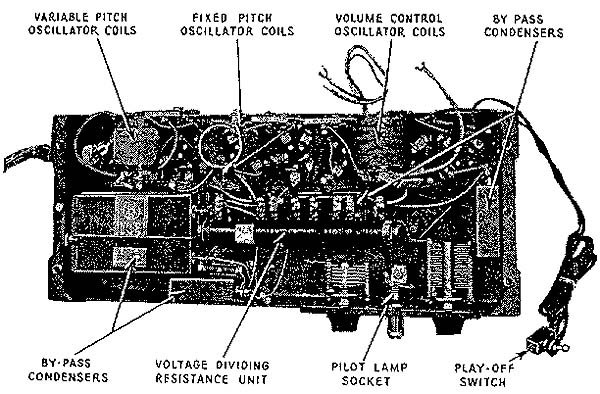Instruments, Technology
RCA Theremin Service Notes
The output of the detector is then amplified by a two-staga audio frequency amplifier, the output of which goes to the loudspeaker. The remaining two tubes, Radiotron UX-120 and UX-17IA together with the first audio frequency amplifier constitute the volume control system. Examining the UXI71A we find that it is in an oscillating circuit that oscillates at about 420 K.C. Connected to the grid side of the oscillator is the volume control loop circuit. This circuit resonates at a frequency below ths oscillator frequency when the hand is entirely removed from the volume control loop. This is done for two reasons. If the two circuits were in exact resonance the load on the oscillator would be too great and operation would be unstable. Also the pick-up current would be high and might damage the tube. The ratio of inductance to capacity in this circuit is also quite high. A small pick-up coil is wound around the inductance coil of the volume control loop circuit and when both circuits are nearly in resonance (hand entirely removed) sufficient radio frequency current flows in this pickup coil to light the filament of the Radiotron UX-120 to which it ie connected. If the plate supply circuit to the Radiotron UY-227, that is the first audio frequency amplifier, is examined we see that the current for this tube is fed through the UX-120. Thus if the UX-120 were at maximum brilliancy, maximum volume would be obtained. Likewise, if it were not lighted no signal output would be obtained due to no plate current flowing.
A condenser and resistor are placed in the plate voltage supply to the first audio tube which regulates the time constant of the volume control. They are adjusted to prevent any undue lag in operation of the volume control, while preventing quick accidental variations in volume due to a slight unsteadiness of the hand. The condenser also increases the efficiency of the audio amplifier by preventing a loss of A.C. voitage across the Radiotron UX-120. The low side of the resistance instead of being connected to ground is connected to a tap on the grid leak of the volume control oscillator. This supplies a small negative potential to the plate of the first audio tube and insures that zero volume is secured when the UX-120 emission is zero or nearly so.
Now getting back to the oscillator circuit that lights the filament of the UX-120 we see that if the load current is reduced, the brilliancy of the UX-120 will be decreased and likewise the volume. Thus when the hand approaches the volume control loop, the natural period of the circuit is decreased in frequency, the circuit is out of resonance with the oscillator by an amount depending on the position of the hand and less current is flowing in the pick-up coil with a consequent reduction in volume.
Thus we see from the foregoing explanation, a movement of one hand in relation to the pitch control rod will cause a variation in pitch and thus allow the playing of music. A movement of the other hand in relation to the volume control loop will cause an increase or decrease in volume. The combination of these two movements constitutes the technique of playing the RCA Theremin.

















